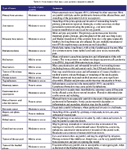Case studies in cancer pain management (Proceedings)
The biggest problem to overcome before treating pain in veterinary medicine is properly identifying the pain. Our patients cannot tell us what they're feeling using intelligible words, or by describing their symptoms. We therefore need other means to determine that the patient is experiencing pain, and to plan an appropriate treatment.
The biggest problem to overcome before treating pain in veterinary medicine is properly identifying the pain. Our patients cannot tell us what they're feeling using intelligible words, or by describing their symptoms. We therefore need other means to determine that the patient is experiencing pain, and to plan an appropriate treatment. A key component in this process is communication with clients. Owners know their animals better than anyone else, and can recognize abnormal behaviour as a reliable sign that something's wrong. A crucial first step is to listen to our clients when they tell us that their animal appears to be suffering. Involving them in the regular reassessment of their pet's comfort and therapeutic planning is important. A simple rule generally applies when one has to determine whether or not a veterinary patient is feeling pain: if an animal seems to be in pain, then it probably is. In doubt, probably the most useful clinical approach to confirming that a patient is experiencing pain is to treat the pain, and watch for clinical improvement following the analgesic therapy.
Certain physiological parameters, such as heart or respiratory rates, body temperature, pupil size and blood pressure, have been used and described as objective variables in assessing pain in veterinary patients. However, these do not appear to be specific enough, given the major influence exerted by other psychological factors associated with the stress of the clinical environment. Behavioural variables thus appear to provide for a better assessment of pain in the clinic. Observing movement, posture, cleaning behaviour, hunger and thirst, licking of painful areas, dysphagia, whining and crying, growling when approached or mainpulated, amongst others, can provide somewhat objective and often more reliable information on the degree of pain a given patient may be feeling.
There are few objective methods to determine how much pain a patient is feeling. Force plates and mats designed to calculate vertical force via computer software may be used to assess gait and the weight applied on each limb. Pressure algometers are devices calculating the pressure that must be applied to reach a pain response at a given site, and have been used in research studies. Others have used somatosensory evoked potentials and pain thresholds as objective measures determining pain and response to certain analgesics. As well, certain studies have evaluated cathecolamines and blood cortisol levels in correlation with the degree of comfort and pain in companion animals. However, there is little use and usefulness of these instruments and circulating hormones in the clinical setting for determining the degree of pain in an individual patient with a given condition.
The American Animal Hospital Association (AAHA) has published Guidelines for Pain Management recommending that pain be evaluated in all patients, regardless of their initial presenting reason. To comply with these standards, the treatment team must adopt a standardized way for assessing pain in the clinic. A number of pain scales have been used to estimate pain in animals. Most frequently used are the visual analog scale (VAS) and the numerical rating scale (NRS). Both scales are represented by a horizontal line that is usually 100 mm long. The NRS is similar to the VAS, with the addition of a scale of 0 to 10 (or 0 to 100), where 0 indicates that there is no pain, and 10 (or 100) indicates the most excruciating pain. With the VAS, the distance between 0 and the place where the line is drawn is measured, and represents the pain score. This method is more subjective, and more susceptible to differences among observers than the NRS is. The NRS usually includes specific descriptive criteria (physiological and behavioural) along with numeric values. Both systems have clear weaknesses. More important than the type of scale used, however, is using a system that everyone on the medical team understands, one that is easy to use in a standardized, repeatable manner. The pain score should be noted for all patients at the initial examination, and regularly reassessed during therapy.
Which cancers cause pain in companion animals?
It is essential to understand that any tumor can cause pain. Pain may be due to the invasion or destruction of surrounding tissues, including nerves and bone. It can also be the result of regional or distant metastases to bone, serous surfaces (abdominal or pleural cavity), or meninges. Similarly, tumors can cause stretching of some visceral organ capsules, or cause a blockage in normal flow (e.g., biliary tract, urinary tract, gastrointestinal tract). Importantly, certain paraneoplastic syndromes can cause a significant degree of pain. Lastly, a tumor can cause pain as a result of an opportunistic infection or secondary inflammation. See Table 1 for examples of pain-causing tumors found in companion animals. This presentation will be based on real-life cases of cancer pain, and the multimodal therapeutic approach used to make cancer-bearing pets as comfortable as possible.

Table 1: Some tumors that may cause pain in companion animals